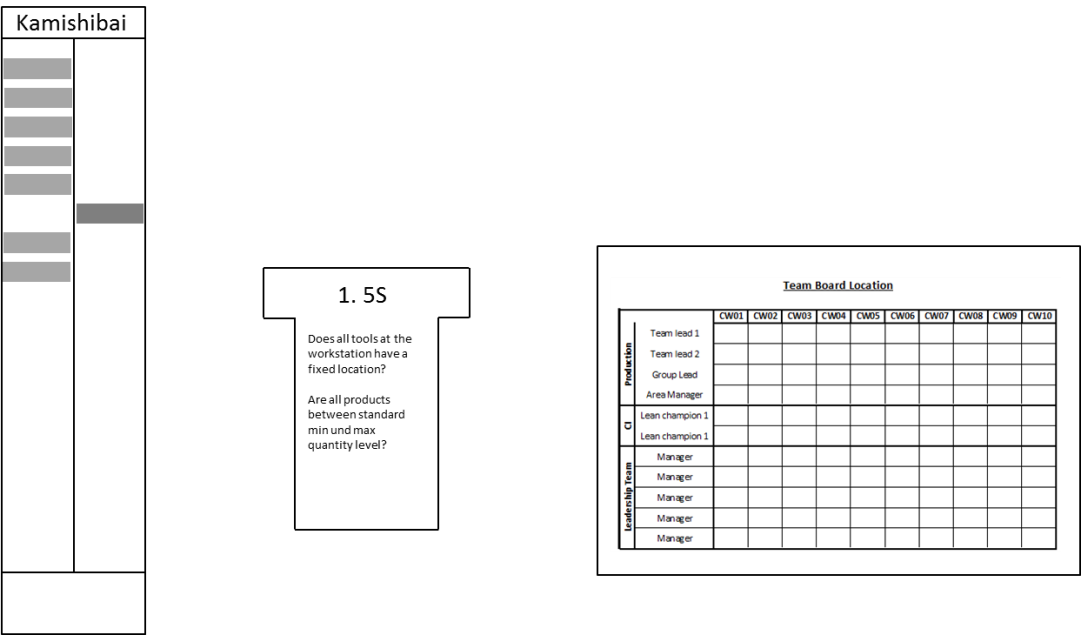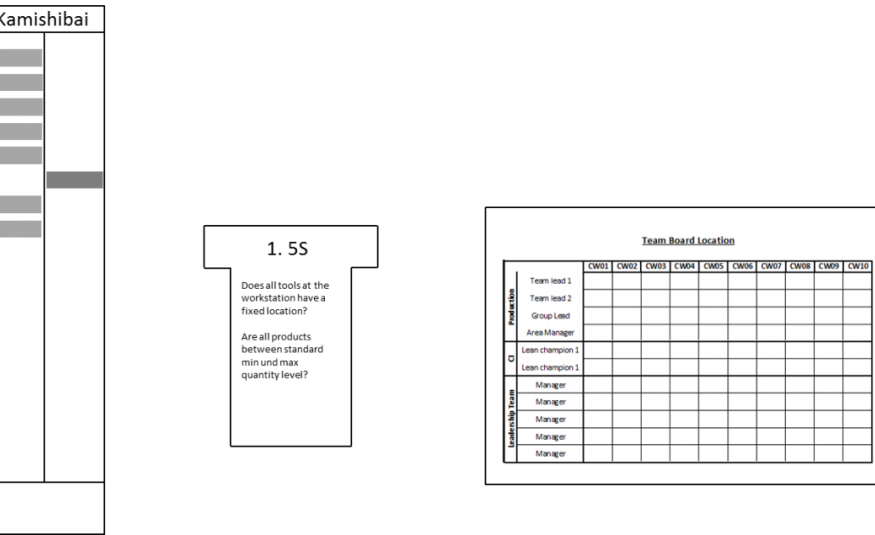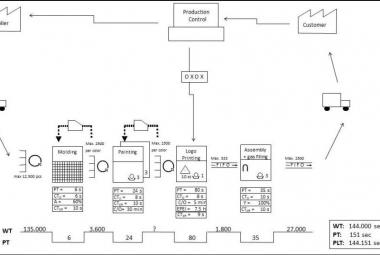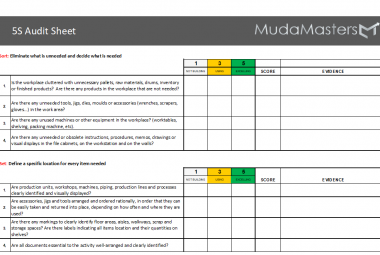Kamishibai is the Japanese tool used for mini-audits. The goal of the mini-audit is to check if the current standards are still valid, kept and help the team in finding the next improvement (Niederstadt, 2013).
The kamishibai is in my opinion one of the most important lean tools, because it can support a lean culture in various ways. It can be used by management at gemba walks, help sustaining 5S efforts, check on implemented improvements and measure performance on behavioral level (Panneman, 2017).
Kamishibai can help managers while they are doing their gemba walks, which means they visit the shop floor to talk to employees about their work, learn about the processes and learn about the problems the people have. Instead of having only general small talk with an employee, the kamishibai card can facilitate a specific process oriented conversation about improvement (Panneman, 2017).
A kamishibai card for 5S can help sustaining a clean, organized and most of all safe workplace. By asking questions like “do all items have a standard location on this workstation?” and “is the workstation cleaned conform standard?” 5S becomes an ongoing process instead of a one-time-cleaning session.
The kamishibai can also check behavior performance, whether people work according to the defined Standard Work in the way that it describes how to perform a certain task. When a person does not work according to standard, there are two possibilities: either the employee is not trained in the way of working and therefore needs training, or the defined standard is unclear (or even wrong) and needs adjustment. The last one results in Kaizen.
Finally, kamishibai can also check the what side of standard work. Even when an improvement is documented into standard work, it is not uncommon for employees to unconsciously slip back into their old way of working. Kamishibai therefore not only helps sustaining 5S, but helps in sustaining the improvements in all standards (Niederstadt, 2013).
Next to checking for deviations from standard way of working, kamishibai can be used to check behavior indicators defined at operational level. Topics could include 5S, safety, team efforts in kaizen and using the 3C board. To be able to perform this way of measuring performance, it is important for Standard Operating Procedures to describe not only what to do at a certain task, but also how to do it.

Illustration 1: example Kamishibai plan board (left) a 5S T-card (middle) and audit history (right) (Panneman, 2017)
The Kamishibai system is visualizedabove and includes the following segments: a plan board, T-cards with one green- and one red side and an attendance list to see who has performed audits. The 3C list on the team board will be used to document outcomes of the kamishibai when necessary, with the reason and the possible countermeasure.
The plan board contains two columns: on the left side, the cards are placed which have not been run this period. On the right side, the result of the audits performed this time period are shown.
Each T-card contains a title, such as ´5S´ or ´standard Work´, with a few simple questions the auditor can ask an employee of choice at the workstation (Niederstadt, 2013). The other side of the card could contain the answers to the question or a hint where the answer can be found, for instance on a server location.
The attendance sheet visualizes who has done a kamishibai audit. This shows who is regularly visiting the gemba and who possibly needs extra training to make him or her feel more comfortable going to the gemba and perform an audit.
When the questions on the card can be answered positively, the cards can be returned with the green side to the front. When one of the questions is answered negatively, the card is put back facing the red side. The deviation of the standard is than written on de 3C list with an explanation and possible solution or kaizen to prevent de deviation from happening again.
Kamishibai cards can be made for all (lean) tools used in an organization (including the kamishibai itself), to check whether they are used properly: to find the next improvement (Rother, 2010). Also, basic knowledge can be repeated during these kamishibai checks. Here are some examples described in Lean Transformations (panneman, 2017):
Safety questions:
- How do I know what kind of protective gear I need to wear?
- What number do I call when there is an emergency?
- Where are the first-aid boxes / fire extinguishers / emergency exits?
5S questions:
- Does everything on this workstation have fixed location?
- How do I know when something is missing?
- How do you know you have all the tools available to do your job?
Standard Work questions:
- Can you show me the SOP for the job you are working on now?
- Can you do your job solely based on what is shown in the SOP?
Team Board questions:
- How can I see that all KPI´s are up to date?
- Are all red KPI´s linked to 3C?
- Do all 3C have a due date and an owner?
- How many of the 3C lead to kaizen?
Kaizen questions:
- When did you implement your last kaizen?
- What improvement are you working on now?
- What is you biggest problem at the moment?
- How can I help you solve your problem?
Kamishibai:
- Did everybody do his or her kamishibai according to standard work?
- Are the kamishibai cards leading to kaizen?
- Were the results of the previous kamishibai discussed in the team board meeting?
Knowledge questions:
- Can you name the 8 wastes?
- Can you name your team goals?
5 coaching questions:
- What is your target condition?
- Where are you today on that KPI?
- What obstacles are preventing you from reach your target condition?
- What experiment are you planning to overcome that obstacle?
- When can we see the results of that experiment
This is an article in de series ‘Lean Toolbox‘,
Continue to:
Lean Toolbox - Autonomous Maintenance
REFENRENCES:
Niederstadt, J. (2013). Kamishibai Boards, A visual management system that supports visual audits. New York: CRC Press. (order this book)
Panneman, T, 2017, Lean Transformations - when and how to climb the four steps of Lean maturity, Maarssen (NL): panview (summary / order this book)
Rother, M. (2010). Toyota Kata: Managing people for Improvement, Adaptiveness and Superior Results. New York: McGraw Hill. (summary / order this book)













